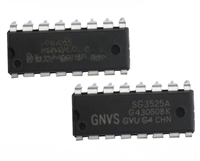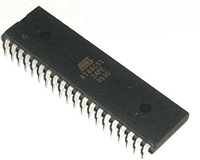SPECIFYING QUARTZ CRYSTALS
A typical quartz crystal specification reads like this:
35.0MHz HC49 15 30 20 SR 3RD BU
Frequency
Frequency Tolerance
The cost of manufacture depends partly on the accuracy
required at the reference temperature (which in the case of
the AT-cut crystal, is usually 25°C).
T
Holder Style
Where high initial accuracy is important the additional
manufacturing cost should be weighed against the cost of
including a frequency trimming facility within the oscillator.
Frequency Tolerance at 25°C
Frequency Stability
Frequency Stability
Lower end of Operating Temp Range
Circuit Condition
Frequency stability is normally specified as a frequency
tolerance over a defined operating temperature range with
respect to the frequency at reference temperature. The
temperature ranges are defined for each crystal in the
relevant data sheet. However the majority of crystals will
continue to operate quite satisfactorily outside the
temperature range for which they are specified, but with a
possible degradation of their frequency stability.
Overtone order
Packaging
Additional Text Code (for non-standard product)
The following notes define each element of the specification.
Frequency
Generalised frequency vs temperature curves for the AT-cut
crystal types are illustrated in the following pages. These
indicate that, without compensation, a crystal specified for
operation over a wide frequency range will probably have an
inferior performance over a narrower range than one whose
design was optimised for the narrower range. The angle of
cut of the quartz blank from its quartz stone determines
which curve will be followed; the chosen angle being subject
to its own tolerance. Thus, since manufacturing cost is
tolerance-dependent it is wise not to specify a wider
operating temperature range than is actually needed unless
some sacrifice of stability, or an increase in cost, can be
accepted.
Frequency is normally specified in kilohertz (kHz) up to
999.999kHz and in megahertz (MHz) from 1.0MHz. All
our computer-generated transaction documents follow this
standard convention automatically.
The frequency should be given to seven significant figures. If
seven significant figures are not used, any figure that might
follow those given will be taken as zero. Thus a frequency
given as 16.6MHz will be taken as 16.60, not 16.66667.
Some specifiers extend the use of kHz to all crystals
operating in fundamental mode, reserving MHz for
overtones. To minimise the possibility of misunderstanding
it is best to use the standard method and specify the mode.
Standard Frequency Tolerances and Stabilities
n
Holder Style
5ppm, 10ppm, 15ppm, 20ppm, 30ppm,
50ppm, 100ppm
Before manufacture of the crystal can start, the holder style
must be defined. If the holder size is not known or it is
unimportant, we will supply the holder normally adopted for
the frequency specified, such as HC49 for the majority of
microprocessor applications. The holder information should
also cover any mechanical variant required such as a top wire
or cropped leads. The following variants for example are
available for most crystals, either singly or in some cases, in
combination:
Operating Temperature Ranges
n
0 to 50°C
–10 to 60°C
–20 to 70°C
–30 to 80°C
–40 to 90°C
–55 to 105°C
–55 to 125°C
When the required temperature range is symmetrical about
25°C, it is indicated in the specification by the lower figure,
ie: –20 to 70°C would read ‘20’ as shown in the example. If
the required temperature range is not symmetrical about
25°C, both figures are used, ie: –55 to 85°C and appear in
the additional text code section (T).
n
3 lead base
n
Top wire
n
Insulating sleeve
n
Taped and reeled
Circuit condition
The characters ‘SR’ are used to denote calibration of the
crystal at series resonance. If it is to be calibrated at load
resonance the characters represent the circuit load
capacitance in pF.
n
Fitted insulator
n
Cropped leads
n
Formed leads
Packaging Codes
Tape & Reel packaging is available as an option on many of
the products outlined in the Quartz Crystal chapter.
Europe Tel: +44 (0)1460 74433 Fax: +44 (0)1460 72578
2
Americas Tel: +1 919 941 0430 Fax: +1 919 941 0530






 SG3525资料手册详解:SG3525参数分析、引脚说明、应用介绍
SG3525资料手册详解:SG3525参数分析、引脚说明、应用介绍

 AT89C51单片机资料手册详细解析及应用示例
AT89C51单片机资料手册详细解析及应用示例

 CP2102资料手册解读:CP2102引脚说明、关键参数分析
CP2102资料手册解读:CP2102引脚说明、关键参数分析

 资料手册解读:UC3842参数和管脚说明
资料手册解读:UC3842参数和管脚说明
